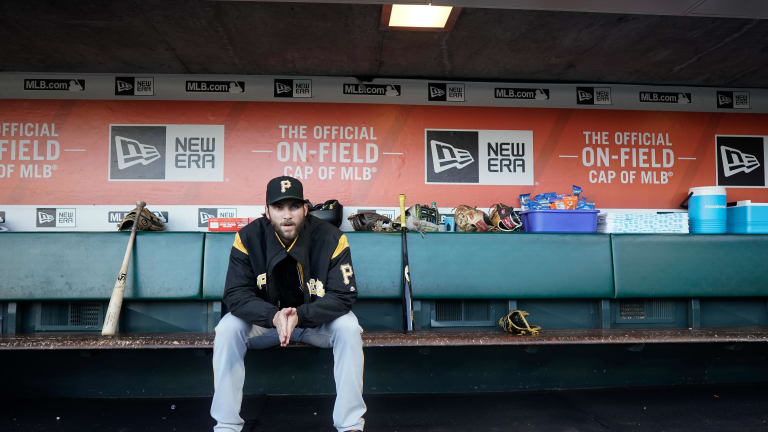
For Pirates' Trevor Williams, Success is a Very Fine Line

For much of 2018, Trevor Williams was arguably the Pittsburgh Pirates most reliable, if not best starting pitcher. 2019 saw injury and a sudden lack of control in the zone, which was the difference between solid starter and very hittable one.
Nobody wants to hear something positive about the pitch to contact philosophy I’m quite sure, but Trevor is a perfect example of a pitcher for which it completely worked. He doesn’t have elite stuff, nothing is going to blow hitters away. It’s hard to even pick out one pitch in particular that you’d hang your hat on if you needed a strikeout. That’s fine. Not every pitcher is built the same and the new regime continually expressing their desire to introduce player-centered development should allow Williams to do what he does best, which is pound the lower portion of the zone with fastballs and accurately paint the corners to exploit weak contact and turn it into outs.
That didn’t happen much in the last season to be kind. Surely the injury to his oblique didn’t help as he started the season very much looking like the same pitcher he was in 2018. Regardless the reason, reality is Trevor can’t get by with almost hitting his spot, he doesn’t have that kind of stuff. Control is his game and when he misses in the zone batters practicing the new tactic of maximizing launch angle hammer him.
Let’s take a look at some data. There are any number of metrics we could use to show the difference between Trevor in ’18 versus ’19 but let’s start with opponents batting averages in different scenarios.
Now, if you happen to be colorblind maybe this doesn’t frighten you but get out those reading glasses and really check out the numbers there. Notice all those numbers up in the zone, a place where Trevor should never play in regularly.
Now let’s look at the same stat but only versus left-handed batters.
Again, up in the zone, and got absolutely hammered. Anthony Rizzo is probably somewhere drooling, in fact that .444 4/9 way inside could very well be all him. Ok, maybe not, those pitches would have hit Rizzo, but you get the point.
This is one stat and we’ll dig into some more in a bit but for now you see the contrast is just crushing. More than any of the starters Williams needs a couple things, first control in the zone, and second an excellent pitch framer behind the dish. He’s a bulldog and every at-bat is a fight, but when your fastball maxes out at 95 MPH when you overthrow, you aren’t going to miss many bats in MLB if it catches too much plate.
Trevor possesses a natural sink with his four-seam fastball, that movement has given him ability to get a nice percentage of groundballs. This too was tested last season as all over the zone his numbers were down.
In this case red is good and you see exactly how many more groundballs Trevor got in ’18 versus ’19 just in the bottom of the zone. In 2019 he needed to leave the zone more often to get results and, when batters stayed disciplined, he was forced to come back int the zone with a typically fat pitch.
Trevor throws a decent changeup but his real change of pace from the fastball is his slider. Check out these charts on how many grooved pitches he tossed that were sliders again ’18 versus ’19.
Allow me to narrate what you’re seeing up there. Trevor started ’18 struggling and caught his groove toward the end of May, rode it and slightly regressed August. In ’19 Williams started very strong and blew up in May along with just about everything else starting pitcher-related for the Bucs. Normalized after returning from injury, hell these charts don’t even have the same top ends.
Grooving his slider is one example of not having control in the zone. His slider, when performing at his top end, dips down and in slightly off the plate to lefties and down and away to righties. Miss by the slightest of fractions and it’s in the sweet spot for any self-respecting left-handed hitter and becomes something a right hander can cover. He doesn’t have the horizontal break to compensate for lack of control, it simply gives batters another look as opposed to the vertical break his fastball carries.
Trevor can find a way to get back to what we watched in 2018 or he could struggle to recapture the magic, either way control is essential, and the line could not be finer for the young man. Just because he doesn’t throw the ball in the upper 90’s doesn’t mean Williams can’t be a very good starting pitcher for years to come, it does mean he can’t get away with the same mistakes as a fireballer however.
Next season will answer quite a few questions about many players but, there is a new sheriff in town and my guess is, as of right now, nobody cares what any of them have been, it's about what they are now. Trevor Williams would do well to harness his form and regain control of his pitches before he loses control of a spot in the rotation.
Follow Gary on Twitter: @garymo2007







